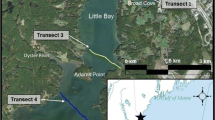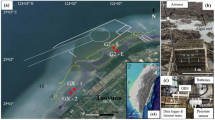Abstract
Pore pressures in the seabed are extremely sensitive to any imposed stress because of the low permeabilities commonly exhibited by marine sediments. Consequently, the measurement of sediment pore pressures can be used to infer either the nature of the imposed stress (if the sediment properties are known) or the physical properties of the sediment (if the imposed stresses are known). Stresses of many different types may be exerted on the seabed either through hydrostatic forces (e.g. tidal and wave effects), or directly by lithospheric forces (e.g. tectonic and thermal forces). Several techniques for measuring in situ pore pressures in the upper few metres of sediments have been developed, and one instrument, the PUPPI, will operate autonomously in water depths up to 6000 m. Basic sediment properties and processes can already be inferred from pore pressure responses using this technique. However, further application and development could greatly enhance its capability, especially for long-term monitoring of sediment conditions. In this Chapter, pore pressure measurement techniques are briefly reviewed and problems are highlighted. An outline is given of some of the many ways in which pore pressure measurements could be used to gain further insight into geological processes and to determine some of the pertinent sediment properties more accurately for engineering applications.
Similar content being viewed by others
References
Abbott D., Menke W., Hobart M., Anderson R. N., and Embley R. W., 1984, Correlated Sediment Thickness, Temperature Gradient and Excess Pore Pressure in a Marine Fault Block Basin. Geophys. Res. Lett. 11(5), 485–488.
Baligh M. M., 1986, Undrained Penetration, II: Pore Pressures, Geotechnique 36(4) 487–501.
Becker K. and Von Herzen R. P., 1983, Heat Transfer through the Sediments of the Mounds Hydrothermal Area, Galapagos Spreading Center at 86°W, J. Geophys. Res. 88, 995–1008.
Bennett R. H., Bryant W. R., Dunlap W. A., and Keller G. H., 1976, Initial Results and Progress of the Mississippi Delta Sediment Pore Water Pressure Experiment, Marine Geotechnology 1(4), 327–335.
Bennett R. H., 1977, Pore Water Pressure Measurements: Mississippi Delta Submarine Sediments, Marine Geotechnology 2, 177–189.
Bennett, R. H. and Faris, J., Ambient and Dynamic Pore Pressures in Fine-grained Submarine Sediments: Mississippi Delta, Applied Ocean Research 1(3) 115–123.
Bennett R. H., Burns J. T., Clarke T. L., Faris J. R., Forde E. B., and Richards A. F., 1982, Piezometer Probes for Assessing Effective Stress and Stability in Submarine Sediments, in Marine Slides and other Mass Movements (Saxov S. and Nieuwenhuis J. K., eds), Plenum Press, London, pp. 129–161.
Bennett R. H., Huon L., Valent P. J., Lipkin J., and Esrig M. I., 1985, In Situ Undrained Shear Strengths and Permeabilities Derived from Piezometer Measurements, in Chaney R. C. and Demars K. R. (eds.), Strength Testing of Marine Sediments: Laboratory and In Situ Measurements. Special Technical Publication 883, American Society for Testing and Materials, Philadelphia, pp. 88–100.
Bennett R. H., Burns J. T., Nastav F. L., Lipkin J., and Percival C. M., 1985, Deep-Ocean Piezometer Probe Technology for Geotechnical Investigations, IEEE Journal of Oceanic Engineering 10(1), 17–22.
Carpentier, R. and Verdonk, W., 1986, Special Pore Water Pressure Measuring System Installed in the Seabed for the Construction of the New Outer Harbour at Zeebrugge, Belgium, International Conference on Measuring Techniques, London, paper C3, pp. 121–135.
De Wolf, P., Carpentier, R., Verdonk, W., Boullart, L., De Rouk, J., de Saint Aubain, T., and De Voghel, J., 1983, In-situ Pore Water Pressure Measurements for the Construction of the Breakwaters of the New Outer Harbour at Zeebrugge, Proceedings 8th International Harbour Conference, Antwerp, pp. 1203–1215.
Dunlap W. A., Bryant W. R., Bennett R., and Richards A. F., 1978, Pore Pressure Measurements in Underconsolidated Sediments. 10th Offshore Technology Conference Proceedings, 2, paper 3168, pp. 1049–1058.
Esrig, M. I., Kirby R. C., and Bea, R. G., 1977, Initial Development of a General Effective Stress Method for the Prediction of Axial Capacity for Driven Piles in Clay, 9th Offshore Technology Conference Proceedings, paper 2943, pp. 495–501.
Francis T. J. G., 1984, A Review of IOS Research into the Feasibility of High-Level Radioactive Waste Disposal in the Oceans, The Science of the Total Environment 35, 301–323.
Garrison L. E., 1977, The SEASWAB Experiment, Marine Geotechnology 2, 117–122.
Gibson R. E., 1963, An Analysis of the System Flexibility and its Effect on the Time Lag in Pore Water Pressure Measurements, Geotechnique 13(1), 1–11.
Hamilton E. L., 1964, Consolidation Characteristics and Related Properties of Sediments from Experimental Mohole (Guadalupe Site), J. Geophys. Res. 69(20), 4257–4269.
Hanna, T. H., 1985, Pore Water Pressure Measurement Devices, in Hanna T. H. (ed.), Field Instrumentation in Geotechnical Engineering, Clausthal-Zellerfeld Trans. Tech. Publications, 843 pp, Series on Rock and Soil Mechanics 10, 121–204.
Hirst T. J. and Richards A. F., 1976, Excess Pore Pressure in Mississippi Delta Front Sediments: Initial Report, Marine Geotechnology 1(4), 337–344.
Hirst T. J. and Richards A. F., 1977, In situ Pore Pressure Measurements in Mississippi Delta Front Sediments, Marine Geotechnology 2, 191–204.
Hottman W. E., Suhayda J. N., and Garrison L. E., 1978, SEASWAB II (Shallow Experiment to Assess Storm Wave Effects on the Bottom), Offshore Technology Conference Proceedings, 2, paper 3169, 1059–1066.
Hurley, M. T., 1989, Biot's Theory of Poroelasticity Applied to Geoacoustic and Hydrodynamic Models of the Sea-bed, Unpublished PhD Thesis, University of Wales.
Hvorslev, M. J., 1951, Time Lag and Soil Permeability in Ground Water Observations. Bulletin No. 36, Waterways Experimental Station, Corps of Engineers, U.S. Army.
Lai J. Y., Richards A. F., and Keller G. H., 1968, In-Place Measurement of Excess Pore Water Pressure of Gulf of Main Clays (Abstract), American Geophysical Union Transactions 49, 221.
Lambert D. N., 1982, Submersible Mounted in situ Geotechnical Instrumentation. Geo. Marine Letters 2, 209–214.
Leinen, M., Schultheiss, P. J., Dadey, K., Becker, K., and McDuff, R., 1990, Ridge Flank Hydrothermal Activity near the Mariana Trough Spreading Center (in prep.).
McPhail S. D. and Schultheiss, P. J., 1986, PUPPI—A Free-Fall Seabed Piezometer for Geotechnical Studies, Advances in Underwater Technology, Ocean Science and Offshore Engineering, Vol. 6: Oceanology, Graham and Trotman Ltd., pp. 249–258.
Noorany I. and Gizienski S. F., 1970, Engineering Properties of Submarine Soils—A State-of-the-Art Review, Proc. American Society of Civil Engineers 96, (SM5) 1735–1762.
Penman, A. D. M., 1960, A Study of the Response Time of Various Types of Piezometer, Proceedings, Conference on Pore Pressure and Suction in Soils, Institution of Civil Engineers, London, pp. 53–58.
Prindle R. W. and Lopez A. A., 1983, Pore Pressures in Marine Sediments—1981 Test of the Geotechnically Instrumented Seafloor Probe (GISP), Offshore Technology Conference Proceedings, Vol. 1 (4463), 173–180.
Prior, D. B. and Coleman, J. M., 1984, Submarine Slope Instability, in Brunsden, D. and Prior, D. B., (eds.) Slope Instability, John Wiley & Sons Ltd., pp. 419–455.
Randolf M. F., Carter J. P. and Wroth C. P., 1979, Driven Piles in Clay—The Effects of Installation and Subsequent Consolidation, Geotechnique 29(4), 361–393.
Reece E. W., Ryerson D. E., Kestly J. D., and McNeill R. L., 1979, The Development of in situ Marine Seismic and Geotechnical Instrumentation Systems. POAC 79, in Proceedings of 5th International Conference on Port and Ocean Engineering under Arctic Conditions, 1, The Norwegian Institute of Technology, Trondheim, pp. 331–334.
Richards, A. F., 1984, Modelling and the Consolidation of Marine Soils, in Denness, B. (ed.), Seabed Mechanics, Graham and Trotman, pp. 3–8.
Richards A. F. and Hamilton E. L., 1967, Investigations of Deep Sea Sediment cores, III. Consolidation, in Richards A. F., (ed.), Marine Geotechnique. University of Illinois Press, Urbana, pp. 93–117.
Richards A. F., Oien K., Keller G. H., and Lai J., 1975, Differential Piezometer Probe for in situ Measurement of Seafloor Pore Pressure, Geotechnique 25, 229–238.
Schultheiss, P. J., McPhail, S. D., Packwood, A. R., and Hart, B., 1985, An Instrument to Measure Differential Pore Pressures in Deep Ocean Sediments: Pop-up-Pore-Pressure-Instrument, (PUPPI). IOS Report No. 202, 57 pp.
Schultheiss P. J. and McPhail S. D., 1986, Direct Indication of Pore-Water Advection from Pore Pressure Measurements, in Madeira Abyssal Plain Sediments, Nature 320(6060), 348–350.
Schultheiss, P. J. and Noel, M., 1987, Evidence for Pore Water Advection in the Madeira Abyssal Plain from Sediment Pore-Pressure and Temperature Measurements, in P. P. E. Weaver and J. Thomson, (eds.), Geology and Geochemistry of Abyssal Plains, Geological Society Special Publication 31, 113–129.
Sills, G. C. and Nageswaran, S., 1984, Compressibility of Gassy Soil, Oceanology International, Brighton, UK, Paper 0I2.6/1., 18 pp.
Silva, A. J. and Jordan, S. A., Consolidation Properties and Stress History of Some Deep Sea Sediments, in Denness, B., (ed.), Seabed Mechanics, Graham and Trotman, pp. 25–39.
Silva, G. C. and Nageswaran, S., 1984, Compressibility of Gassy Soil, Oceanology International, Brighton, UK, paper OI2.6/1., 18 pp.
Silva, A. J. and Jordan, S. A., 1984, Consolidation Properties and Stress History of some Deep Sea Sediments, in Denness, B., (ed.), Seabed Mechanics, Graham and Trotman, pp. 25–39.
Silva, A. J. and Mairs, H. L., 1987, Stress History and Geotechnical Properties of Nares and Madeira Abyssal Plain Sediments, Marine Geomechanics Laboratory, Dept. of Ocean Engineering, University of Rhode Island Technical Report, 161 pp.
Soderberg L. O., 1962, Consolidation Theory Applied to Foundation Pile Time Effects, Geotechnique 12, 217–225.
Terzaghi K., 1943, Theoretical Soil Mechanics, John Wiley & Sons, New York.
Vaughn P. R., 1973, The Measurement of Pore Pressures with Piezometers, in Field Instrumentation in Geotechnical Engineering, John Wiley, NY, pp. 411–422.
Westbrook G. K. and Smith M. J., 1983, Long Decollements and Mud Volcanoes: Evidence from the Barbados Ridge Complex for the Role of High Pore Water Pressures in the Development of an Accretionary Complex, Geology 11, 279–283.
Working Group 3, 1987, Fluid Circulation in the Crust and Global Geochemical Budget, in Report of the Second Conference on Scientific Ocean Drilling (COSOD II), Strasboug, France, European Science Foundation, pp. 67–86.
Author information
Authors and Affiliations
Rights and permissions
About this article
Cite this article
Schultheiss, P.J. Pore pressures in marine sediments: An overview of measurement techniques and some geological and engineering applications. Marine Geophysical Researches 12, 153–168 (1990). https://doi.org/10.1007/BF00310570
Received:
Accepted:
Issue Date:
DOI: https://doi.org/10.1007/BF00310570




